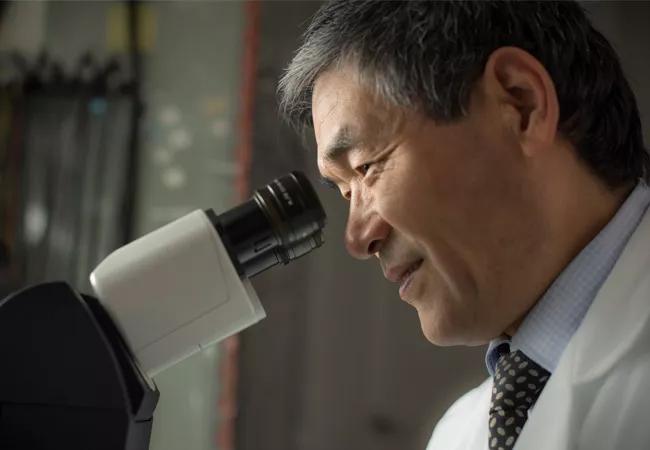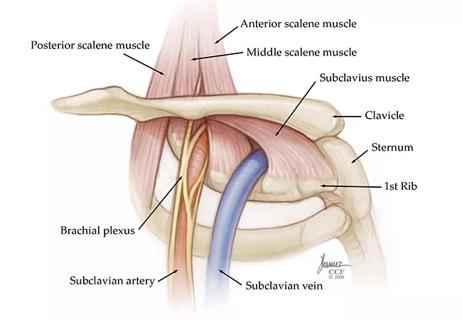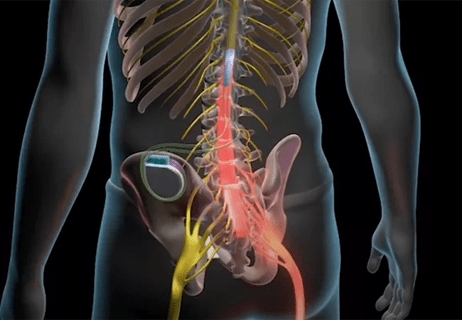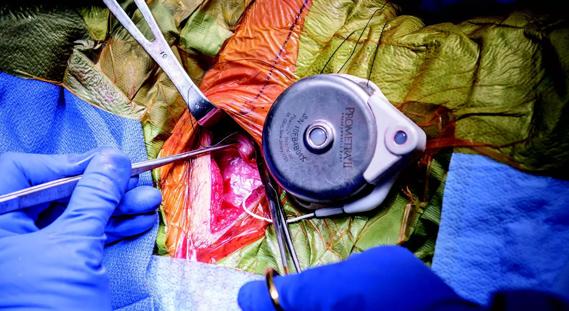Animal studies demonstrate effectiveness

Stem cell research at Cleveland Clinic could pave the way for an entirely new approach to chronic pain treatment that reduces medicine’s current reliance on opioid therapy for intractable pain. The modality also shows promise as a tool to reverse opioid tolerance (OT) and opioid-induced hyperalgesia (OIH), particularly problematic side effects of opioid therapy. Jianguo Cheng, MD, PhD, and his colleagues at Cleveland Clinic have developed patented methods of attenuating opioid tolerance.
Advertisement
Cleveland Clinic is a non-profit academic medical center. Advertising on our site helps support our mission. We do not endorse non-Cleveland Clinic products or services. Policy
Animal studies by Dr. Cheng and his colleagues have demonstrated the effectiveness of mesenchymal stem cell (MSC) transplantation in reducing hyperalgesia due to nerve injury. The group’s work has shown MSC transplantation’s effectiveness in reducing pain induced by sciatic nerve injury in rats and mice. MSC transplantation significantly reduced pain sensitivity evaluated by foot withdrawal thresholds in animals in response to thermal or mechanical stimulation. These cells produced immune modulatory and anti-inflammatory effects, promoted sensory nerve repair, and showed strong analgesic properties that could provide a safer and more effective alternative to current treatment modalities, in the management of neuropathic pain, says Dr. Cheng, Professor of Anesthesiology and Director of the Cleveland Clinic Multidisciplinary Pain Medicine Fellowship Program.
Pain medicine researchers are searching for an alternative to opioid therapy because neuropathic pain often does not respond to morphine and other opioids. Opioid analgesics can also lead to a variety of complications, ranging from itching and constipation to dependence, addiction, respiratory depression and death.
About 30 percent of neuropathy cases are caused by nerve damage associated with diabetes. However, hundreds of diseases are linked to neuropathic pain. Sources of neuropathic pain include alcoholism, amputation (which can result in phantom pain), some chemotherapy drugs (for example, Cisplatin®, Paclitaxel®, Vincristine®), radiation therapy, complex regional pain syndrome type II, trigeminal neuralgia, shingles, spinal stenosis, and central nervous system disorders, such as Parkinson disease and multiple sclerosis.
Advertisement
Recent research by Dr. Cheng and his group has yielded new discoveries that bode well for MSC transplantation as a potential future treatment modality. One investigation compared the analgesic effects of MSC derived from bone marrow with MSC derived from adipose tissue. Adipose-derived cells were found to be as efficacious as bone marrow-derived cells in reducing neuropathic pain in rats. The finding suggests that stem cell therapy could offer a practical option because stem cells from adipose tissue are relatively easy to obtain.
Recent investigations by Dr. Cheng and his colleagues comparing the analgesic effectiveness of intrathecal versus intravenous methods of MSC transplantation show both methods to be equally effective. The finding has important implications because intravenous transplantation of MSC could offer a safer and more expeditious route of delivery than intrathecal transplantation.
“We originally thought that stem cells would have to be introduced intrathecally in order to reduce pain, and that stem cells introduced intravenously would pass through the lungs and fail to produce analgesia,” says Dr. Cheng. “The finding that intravenous transplantation is as effective as intrathecal transplantation is encouraging.”
Dr. Cheng’s group has also discovered that MSCs can be found in the area surrounding the injured nerve following MSC transplantation. “For reasons we do not yet fully understand, these cells have the ability to migrate to the injury site to promote repair of the injured nerve fibers,” Dr. Cheng says. “The cells can sense the injury’s location and travel to it.”
Advertisement
Although many questions must be answered before it can be known whether stem cell therapy is safe and effective for humans, some small patient studies show potential, Dr. Cheng says. According to one observational study in Australia, MSC transplantation reduced pain in patients suffering from trigeminal neuralgia, a particularly difficult condition to treat. “Though the findings are preliminary, the study provides some evidence that what we have learned in the laboratory can be translated to clinical use,” Dr. Cheng says.
Dr. Cheng’s team has achieved analgesia with MSC transplantation from rats to mice, providing early evidence that stem cells’ anti-inflammatory and immuno-modulatory properties can be transferred between species. An important pre-clinical study will be to see whether the transplantation of human stem cells to animals also can produce analgesic and anti-tolerance effects, Dr. Cheng says.
Dr. Cheng’s team presented research at the 2016 annual meeting of the American Academy of Pain Medicine showing MSC’s potential to reverse opioid tolerance and opioid-induced hyperalgesia, problems that can compromise the safety and efficacy of opioid therapy. Intravenous transplantation of bone marrow-derived MSC significantly attenuated OT and OIH in animals whether the transplantation was performed seven days before or 14 days after the initiation of daily morphine injections. These data demonstrate that MSC transplantation can not only prevent the development of OT and OIH but can also reverse it.
Advertisement
Advertisement

Researchers seek solutions to siloed care, missed diagnoses and limited access to trauma-informed therapies

Study participants also reported better sleep quality and reduced use of pain medications

Two-hour training helps patients expand skills that return a sense of control

Program enhances cooperation between traditional and non-pharmacologic care

National Institutes of Health grant supports Cleveland Clinic study of first mechanism-guided therapy for CRPS

Pain specialists can play a role in identifying surgical candidates

Individual needs should be matched to technological features

New technologies and tools offer hope for fuller understanding